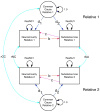The ABCD study of neurodevelopment: Identifying neurocircuit targets for prevention and treatment of adolescent substance abuse
- PMID: 29038777
- PMCID: PMC5639722
- DOI: 10.1007/s40501-017-0108-y
The ABCD study of neurodevelopment: Identifying neurocircuit targets for prevention and treatment of adolescent substance abuse
Abstract
Substance use disorders (SUD) can be considered developmental disorders in light of their frequent origins in substance initiation during adolescence. Cross-sectional functional magnetic resonance imaging (fMRI) studies of adolescent substance users or adolescents with SUD have indicated aberrations in brain structures or circuits implicated in motivation, self-control, and mood-regulation. However, attributing these differences to the neurotoxicological effects of chronic substance use has been problematic in that these circuits are also aberrant in at-risk children, such as those with prenatal substance exposure, externalizing disorders (such as conduct disorder), or prodromal internalizing disorders such as depression. To better isolate the effects of substance exposure on the adolescent brain, the newly-launched Adolescent Brain Cognitive Development (ABCD) study, funded by the National Institutes of Health, will follow the neurodevelopmental trajectories of over 11,000 American 9/10-year-olds for 10 years, into emerging adulthood. This study will provide a rich open-access dataset on longitudinal interactions of neurodevelopment, environmental exposures, and childhood psychopathology that confer addiction risk. The ABCD twin study will further clarify genetic versus experiential influences (e.g., substance use) on neurodevelopmental and psychosocial outcomes. Neurocircuitry thought to regulate mood and behavior has been directly normalized by administration of psychoactive medications and by cognitive therapies in adults. Because of this, we contend that ABCD project data will be a crucial resource for prevention and treatment of SUD in adolescence because its cutting-edge neuroimaging and childhood assessments hold potential for discovery of additional targetable brain differences earlier in development that are prognostic of (or aberrant in) SUD. The ABCD sample size will also have the power to illuminate how sex differences, environmental interactions and other individual differences interact with neurodevelopment to inform treatment in different groups of adolescents.
Keywords: Addiction; Adolescence; Depression; Development; Impulsivity; Neuroimaging.
Figures

References
-
- Hingson RW, Heeren T, Winter MR. Age at drinking onset and alcohol dependence: age at onset, duration, and severity. Arch Pediatr Adolesc Med. 2006;160:739–46. - PubMed
-
- Newton-Howes G, Boden JM. Relation between age of first drinking and mental health and alcohol and drug disorders in adulthood: evidence from a 35-year cohort study. Addict Abingdon Engl. 2016;111:637–44. - PubMed
Grants and funding
LinkOut - more resources
Full Text Sources
Other Literature Sources
